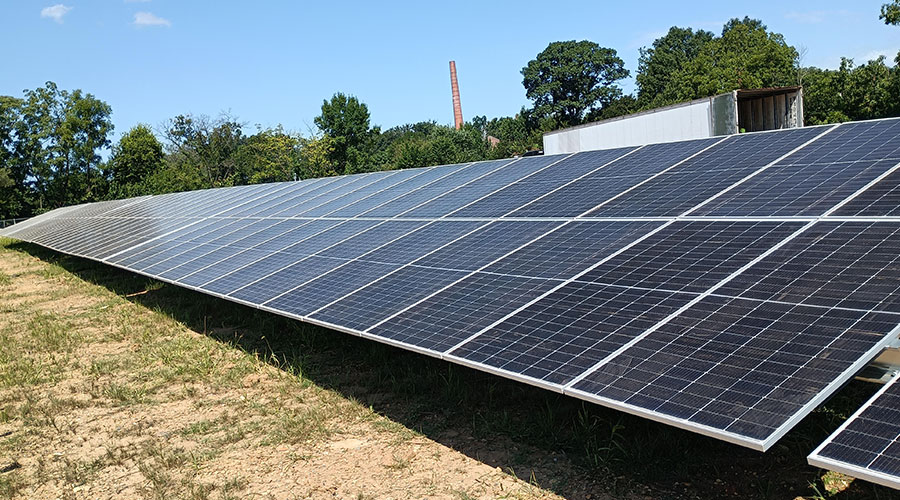Power of Persuasion
Using low-cost measures and big picture thinking, Brenna Walraven is selling commercial real estate on energy efficiency
By Brandon Lorenz, Senior Editor
When it comes to sustainability, there are facility executives who have hopped on the bandwagon and those who are watching it roll by. And then there are those, like Brenna Walraven, who are wondering why the bandwagon isn’t rolling a little faster.
As executive managing director for USAA Real Estate Company, Walraven made energy efficiency measures a cornerstone for the company, which manages 35 million square feet of property. In the process, she played a key role in spreading the message of energy efficiency across the commercial real estate industry, long seen as laggard when it comes to saving energy.
How did she do it? A series of small steps and a sales strategy that other facility executives might do well to emulate. That strategy: finding projects with small up front costs and healthy returns.
A telling measure of Walraven’s success comes from the ENERGY STAR Label for buildings program. When Walraven launched her efficiency program, the average score across the portfolio was 47. ENERGY STAR requires a score of at least 75 to earn a label. Roughly 40 percent of the buildings in the USAA portfolio hit the mark in just three years. And by the end of 2006, the average score had shot up to 81 — a 62 percent increase compared to 2000.
When Walraven started talking about launching an efficiency effort, most people at USAA thought the firm was already doing a pretty good job in the energy arena. But when the results of the first benchmarking came in, Walraven had added ammunition to pursue her efficiency program using ENERGY STAR. In the years since then, Walraven has helped USAA develop a systematic process for improving efficiency, one specifically designed to overcome some of the obstacles inherent in a commercial real estate portfolio.
When USAA takes over a building, staff is charged with making sure the building is operating properly. Then an ENERGY STAR benchmark is conducted to gauge the need for improvement.
Six months after establishing the baseline, Walraven starts evaluating what needs to be done to improve the building’s performance. USAA is especially keen on improving the buildings with the lowest scores. “Our resources are fixed,” says Walraven. “There is only so much capital to invest, so we look at the worst performers.”
The first measures considered are the low- and no-cost energy efficiency improvements. “What we’re trying to say is that you can do a lot just by operating better,” Walraven says. “That’s not a consultant trying to sell you something. It’s coming from the real estate people.”
One common misconception, Walraven says, is that efficiency improvements depend mostly on capital funds to address building flaws. But the Commercial Buildings Energy Consumption Survey (CBECS) done by the Department of Energy found that the worst performing buildings (the bottom 25 percent) had more advanced technology than the top-performing buildings.
In the worst performing buildings, 73 percent had economizers, 56 percent had energy management systems (EMS) and 45 percent had variable speed drives. By contrast, only 22 percent of the top performing buildings had an EMS. “The presence of state-of-the-art systems and technology doesn’t guarantee good performance,” Walraven says. “Operations is a much bigger part of the equation.”
Some of the measures USAA has used in the past to reduce costs include shutting off escalators after hours and dimming the lights in parking garages at night after employees leave.
Walraven also stresses the benefits of having engineers walk a building periodically at night. One example she often cites is a building in Houston that had unusually high utility bills. A night audit found faulty relays were keeping some building equipment operating, even though the EMS said the units were off. Replacing the relays, which cost less than $1,000, helped shave 10 percent off electricity costs and reduce wear and tear on the equipment, says Walraven.
Another common tactic is for USAA to ask tenants for permission to stop providing them with air conditioning on Saturdays unless they specifically request it. Many tenants have leases written that require Saturday service, but very few actually use it, says Walraven. “There is absolutely no cost, and it helps you better connect with the tenants,” she says.
Not every measure falls into the category of low-cost/no-cost. But even projects with significant investments can have quick paybacks. For example, paybacks for lighting retrofits can be as short as one year, depending on the type of rebates available. If the system is due for a relamping anyway, an upgrade can be especially attractive. “Even if you didn’t budget for it, the net effect is you are going to lower expenses by more than it would cost to buy bulbs. Most folks can do that,” says Walraven. EMS is also low risk, and typically earns a return after three to five years.
While efficiency strategies are important, it isn’t always the dominant factor in decision making, according to Walraven. “This is still the real estate business,” she says. “If a storm hits and we have a roof failure, we’re not saying we should buy an EMS.”
The ENERGY STAR Advantage
One advantage that comes from using ENERGY STAR to benchmark all the buildings in the company’s portfolio is that performance-based comparisons can be made between individual buildings. Without ENERGY STAR, comparing buildings with different utility rates can be difficult.
Occupancy can also have a huge impact on cost — a building with lower occupancy than a similar-sized building nearby might have lower costs, but not be as efficient. ENERGY STAR can make it easier to compare complex buildings.
In addition, Walraven uses the ENERGY STAR rating to help drive the need for continuous improvement. “Engineers think they are doing it all, and a lot of engineers are doing a good job. But it needs to be a continuous process,” Walraven says. She also benchmarks energy costs per square foot against the market. And she tracks occupancy, size, hours of occupancy and the type of space in each building.
USAA has been awarded the ENERGY STAR Partner of the Year award for four consecutive years. And while Walraven doesn’t plan on stopping at a four-peat, her efficiency efforts aren’t motivated just by awards.
“Whether you believe in global warming or not you are going to be forced to execute,” she says. “You need to put things in a business perspective. A high performance, sustainable building says we are doing our best for the environment and doing our best in terms of the employee and the business.”
Efficiency in Demand
Walraven has been a trailblazer in many ways. For seven years, she’s successfully run an energy efficiency program at USAA, even though many commercial real estate firms have long been resistant to the idea. She served as the chair of the BOMA Energy Efficiency Program (BEEP) during its first year to further promote energy efficiency in commercial real estate. And she is the first female Chairman-elect of the Building Owners and Managers Association (BOMA) International, an appointment that gives her a bully pulpit to deliver the message of the importance of energy efficiency.
Her approach recognizes the importance of honing communication and negotiation skills, particularly when dealing with the C-suite. “When I first started, I would get someone else to do it,” she says. “Even though it’s not comfortable for me, what I realized is that the skill is important for me to be successful.”
Butterflies or not, Walraven finds herself in demand as a speaker. Her success at making the case for energy saving measures has attracted attention inside the company and out. Within the commercial real estate industry, she has played a role in driving home the message that energy efficiency is a cost-effective business strategy.
Within USAA, her efforts are paying dividends. USAA has cut energy consumption each year since the program was launched in 2001. During that time, small successes have led to bigger ones, and best practices have spread throughout the organization. The result has been dramatic. Last year, USAA cut energy consumption by 6 percent — the most it has saved in one year — for $2.1 million in savings. Since 2001, the company has saved more than $10 million by reducing consumption.
“We’re really seeking continuous improvement,” Walraven says. “We may never get an ENERGY STAR Label on all of our buildings because of the types of tenants or the design, but we still seek to improve, not by looking at cost but by looking at the ENERGY STAR rating.”
|
ENERGY EFFICIENCY
Baby Steps to Energy Savings
Walraven’s commitment to energy efficiency is driven by a long-held belief that it’s the right thing to do. As a student athlete involved in four sports, Walraven recalls staring at smog surrounding the hills near her Southern California home and being unable to practice outside. In the years after Walraven graduated college and the Clean Air Act took hold, the haze gradually faded. The lesson? “Industry and government agencies, and more broadly, people, can take action to improve the environment in a meaningful way,” says Walraven.
And yet, when making the case for energy efficiency projects she talks about a different kind of green — ROI and paybacks. “To sell it properly, you have to sell it in the investment vernacular,” she says. “It’s an investment decision.”
Walraven points to the BOMA Energy Efficiency Program (BEEP) as one way to find no- and low-cost ways to save energy, and to sell the projects to management.
The BEEP program smashed expectations in 2006, its first full year. The initial target was to recruit 500 people for the program, which is split into six seminars. The program trained 5,000 people in low- and no-cost ways to reduce energy costs in its first year. Each seminar runs two hours and costs members $99.
The key to starting an efficiency program, in Walraven’s experience, is to start small, with projects that either have very attractive paybacks or require very little upfront investment. “We started with very low cost items and good paybacks by saying, ‘It would cost $3,500 and here’s what we can save,’” she says. Eventually, creating a track record by stringing together small successful projects not only makes it easier to win approval on bigger projects, but it also improves morale among the facility team.
While some commercial real estate firms have active, sophisticated approaches to sustainability, there still remains a large portion of the market that hasn’t signed on to the idea yet, says Walraven. “The other 85 percent of the market does need some education,” she says. “We want people to get started and see that they can do it without capital.”
Click here for more about BEEP
|
Greening the Portfolio
USAA’s green efforts aren’t limited to energy efficiency. For example, the company is cooperating with the U.S. Green Building Council (USGBC) on a pilot project that would look at a company’s entire portfolio, instead of certifying individual buildings under the Leadership in Energy and Environmental Design (LEED) program, Walraven says.
Energy, green cleaning processes, recycling, waste reduction, reducing the amount of toxins in a building and water efficiency are among the factors to be considered in the portfolio program, she says.
“Our goal is to absolutely drive the business case for sustainable operations,” says Walraven.
|
|
WHAT TENANTS WANT
Greening the Way to Tenant Satisfaction
Most decisions about efficiency hinge on the cost savings available from the project. That’s understandable — the bottom line savings generated by a reduction in energy use can be significant. But it’s not the whole story. Pursuing a green strategy for corporate real estate can also aid efforts to boost tenant satisfaction.
“People think energy efficiency means conservation,” says Walraven. That term conjures up images of employees wearing sweaters in January as thermostats are adjusted to cut energy use. But that’s old-school thinking. “Energy efficiency really supports making people comfortable,” she says.
Walraven sees energy efficiency as a green strategy, and that also aligns with USAA’s strong service-oriented culture. “Anything I can do to get a big tenant is good,” Walraven says.
“Service is really key to our culture,” she says. “Instead of being ad hoc and reactive, we’re trying to be predictive and proactive.”
Being proactive on a customer service front for USAA means being green. Buildings operate within a range of temperatures. But efficient buildings narrow the range of temperature variation, which improves the comfort of occupants. Efficient buildings are also better suited to handle growing occupancy, Walraven says.
“Part of that menu of things that adds value is energy efficiency. Better temperature control can make the building more effective and do it in a way that can lower operating costs,” she says.
Although some lease structures work against investments in efficiency, Walraven has found that improving energy performance benefits everyone. “It’s absolutely in the tenants’ interests to control those costs in the long term,” she says.
A common, but often overlooked lease clause allows the owner to charge a tenant for energy efficiency improvements, even if it is considered a capital cost. The key is that the cost has to pass a “reasonableness test,” she says.
“I’ve been through many audits, but I’ve never had an issue raised about installing an EMS for energy savings,” she says. “It just hasn’t been challenged.”
Tenant satisfaction has stood at 98 percent over the last three years, a company record that Walraven attributes, in part, to the company’s green efforts. “We believe in sustainable operations, energy efficiency, effective cost management and in doing so not only without sacrificing service but rather with an increase in comfort and service,” she says.
|
Related Topics:











